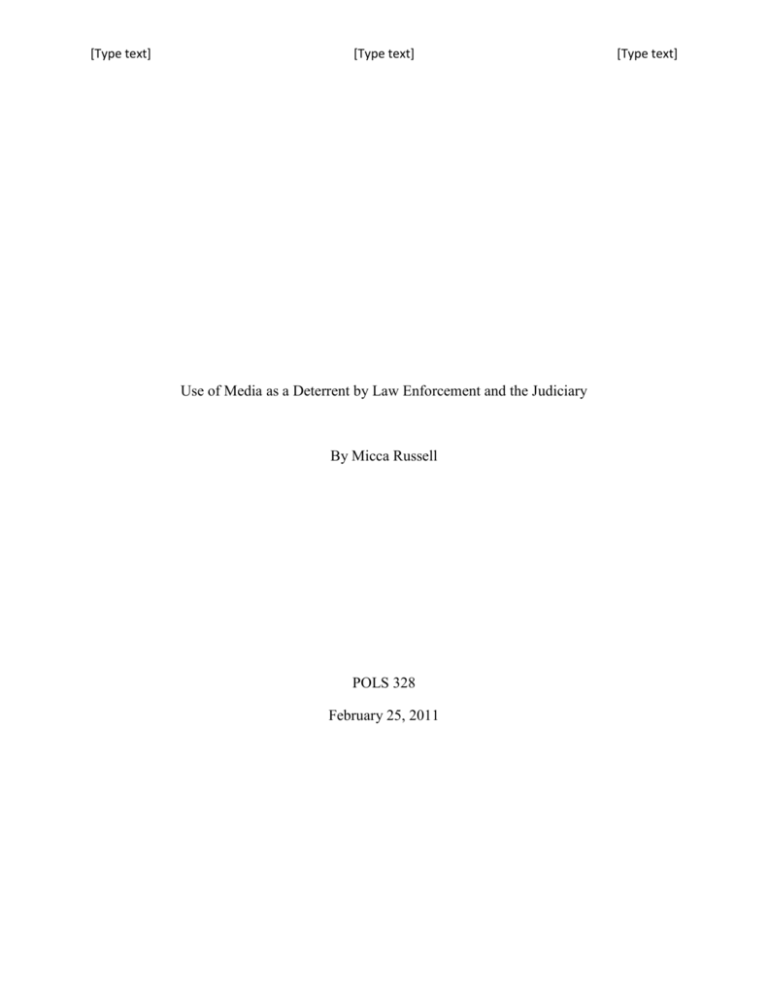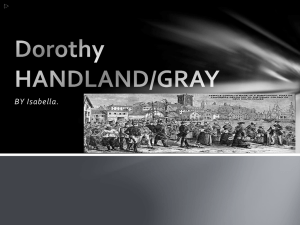Type text
advertisement

[Type text] [Type text] Use of Media as a Deterrent by Law Enforcement and the Judiciary By Micca Russell POLS 328 February 25, 2011 [Type text] Russell - 2 Throughout history, society has often used public shame as both a form of punishment and a deterrent to others. From using the stocks in medieval Europe to punish criminals, to “scolds,” a dunking in the town horse pond, in colonial New England, that punished women who were too free with their opinions, public ridicule has been regarded as a just punishment. "A little shame can go a long way. Sometimes it's good for people to feel bad. Let those who would beat their wives, steal their neighbours' property and abuse children feel the sting of community intolerance. Let them hear their names on our lips and pay the price in view of the public…Shame on them, or shame on us, says Texan Judge Ted Poe (El Nasser)". In the modern media environment, the use of humiliation and/or shaming techniques has tended to follow a cyclical pattern. In the watchdog era of journalism of the 1970’s, the news show “60 Minutes” used a hidden camera to expose people in unsavory situations. Anti-crime groups sprouted up over the next few decades and began making names for themselves-and did their own name calling, like the popular television show “America’s Most Wanted.” However, not until the mid-to late 1990’s did the trend seem to become prevalent again in the use of alternative sentencing. Along with judge’s discretionary sentences, which will be discussed in further detail, attention has also been given to the branding of certain criminals by legislators. Bills have been passed in order to label DUI and sex offenders using specialized license plates and signs. With the new media of today, the use of the internet has begun another wave in humiliating offenders. Law enforcement has begun posting mug shots of offenders online, and the public has even taken it upon themselves to solve their own crimes when they feel the police are too slow in response by posting videos of offenders to YouTube. Russell - 3 The types of crimes that these punishments would deter are often what people consider to be “petty” offenses, such as shoplifting, vandalism and littering, but could range to sexual assault, domestic abuse, and driving under the influence. Now, shame is no panacea to solve crime and there are many crimes of passion where a person would not have the presence of mind to stop and consider how this act would look to the public; however, if a person knew for sure that they would have to announce to the world that they had knocked down an old lady for her purse, they may think twice before grabbing that purse strap. This public humiliation has come in several forms and at different times in the criminal justice process. Law enforcement has begun using social media as arena to alert the public to the wrongdoings of their fellow citizens. Mugs shots, photographs taken as part of the arrest process, have been used on virtual walls of shame throughout the country for offenses including shoplifting, driving under the influence, and sex offenses. There have been many critics of this policy, citing the suspect’s inherent innocence until proven guilty. Another area that has received the same criticism is the so-called “perp walk.” This walk, short for perpetrator walk, is one in which the charged suspect is paraded in front of the media on the way to jail or court appearances in the custody of law enforcement. Many times the media is alerted to the location of these walks in advance, in order to allow access to photographs. These are completed during all points of the criminal justice process, but receive a majority of press shortly after the subject’s arrest. Judges are called upon to decide when the press is allowed to photograph and/or release the identity of some suspects during trial. In the United States this most often occurs when Russell - 4 the offender is a juvenile. In other countries, such as Australia, the identity of sex offenders can be kept secret in order to protect their rights and that of their family. However, society’s safety and right to know must also be weighed in these considerations. The final step of the criminal justice processing, the sentence, is where the judiciary has the most discretion in the use of public shaming. The claims of innocent until proven guilty are gone and the convicted offender must comply with the sentence. The varied sentences are as interesting and inventive as the judges that impose them: Minor burglary-man sentenced to stand on a street corner for three hours on each of three days, carrying a sign that read: “I’m a convicted thief (El Nasser).” Drug-dealing-woman sentenced to wear a sign that read: “I’m a convicted felon. I sold prescription drugs (El Nasser).” DUI-person sentenced to stand on a busy street corner with a sign that read: “I’m a convicted drunk driver (El Nasser).” Domestic battery-man sentenced to make a public apology in front of the media on the steps of city hall (Steinback). Burglary-victims of burglary allowed to visit the thief’s home to “steal” an item back (El Nasser). Domestic battery-wife was allowed to spit in offender’s face (El Nasser). A man was forced to erect a sign outside his house that read: “Warning-a violent felon lives here. Travel at your own risk (El Nasser).” Shoplifting-man sentenced to place his photograph in a local newspaper advertisement, along with the headline: “I am a convicted thief (El Nasser).” Theft-man sentenced to parade in front of the shop he stole from, wearing a sign that read: “I stole from this store. Don’t be a thief. This could happen to you (El Nasser).” Child molester sentenced to post a sign on his home warning children to stay away (Steinback). Child molester sentenced to wear a t-shirt advertising his conviction (Steinback). Drugs-woman sentenced to place a newspaper advertisement that she had bought drugs while her children were in the car (Steinback). Juvenile offender sentenced to be chained to her mother for a month (Steinback). Petty theft-man sentenced to shovel horse manure for 30 days (Steinback). Solicitation of a prostitute-“Johns” sentenced to sweep the streets littered with used condoms (El Nasser). Domestic battery-men sentenced to apologize to their wives in front of women’s groups (El Nasser). Russell - 5 Vandalism-teenager who vandalized 13 schools sentenced to go back to all of the schools, apologize to the students and answer questions, including “Why are you so mean (El Nasser)?” DUI-man sentenced to put a “Convicted DUI” sticker on his license plate (El Nasser). Child molester ordered to take out an advertisement in two newspapers that included his picture, an apology and a plea for other potential molesters to get help (El Nasser). Fraud-man who stole $30,000 from his company was sentenced to give a 15 minute speech apologizing to his colleagues (Campbell). Obviously, the judges who impose these sentences believe in their validity. Judge John Whitfield of Biloxi, Miss., states “When I get first-time nonviolent offenders, I try to shock them…I have a zero recidivism rate: Everyone who has stood with the sign has not stood again in my courtroom (El Nasser)”. Whitfield has imposed 37 sign sentences. Studies have shown that the use of shaming allows the public to express their displeasure in the behavior of the individual. In doing so, this creates a deterrent effect for individuals. This effect is seen the most among the people in society who have the most to lose; those who have a middle-to-high class social status and are more likely to accept societal norms. However, the embarrassment factor of being forced to acknowledge their crime causes even those of the lower class to reassess their behavior. A number of the subjects that have served these unorthodox sentences seem to agree. One thief stated that he had 27 convictions and deserved what he had gotten. The man who was sentenced to shovel horse manure was going to be sure to remain current on child support. Not everyone agrees, however. Many defense attorneys contend that their clients are being unfairly punished and call such sentences a form of “cruel and unusual punishment,” although they have been held to be constitutional. Lack of self-esteem in the first place by Russell - 6 these offenders means that they do not have that far to go down, so social stigma will not play a major threat to them. The idea of shame and embarrassment also indicates that an offender would feel remorse for committing the crime, which is not always the case. And the fact that these offenders sometimes have addictions means that they do not choose to commit these crimes in the first place, as the following case shows. In Tazewell County, Illinois Penny Wood, a 40 year old methamphetamine addict and grandmother signed a plea agreement that allowed her mug shots to be used as part of an anti-meth campaign. The photographs, taken four years apart, were worth a thousand words in how the drug ravages the human body. "It was to be used for drug-education purposes only, to keep kids off drugs," Wood said. "Because that picture would. If that picture doesn't shock a child, I don't know what will (Columbia)". But, living in a small town of 33,000 did not allow the anonymity that Wood had counted on. Wood, and her family, were soon the subjects of ridicule. Wood garnered international attention as she complained that her grandchildren were taunted at school. She stated that she was now clean and sober and wanted to move on with her life. But, the photographs seemed to be an overwhelming success when the purpose was taken into consideration. Interviews of subjects viewing the photographs overwhelmingly indicated that they definitely influenced their perception of the drug methamphetamine. However, it is unclear whether current or past users were influenced in any significant manner. There has been limited studies based on the effectiveness of shaming, especially in the world of social media, however, juveniles seem to respond more to these types of punishments. Juveniles often enter into the system completely aware of the fact that there Russell - 7 are limited options available when dealing with them. They see jail as a status symbol. This is why judges have turned to alternative sentencing options. A hardened street kid having to walk down the street in a pink jumpsuit doesn’t look quite as tough, and may improve his attitude. At the juvenile level, there is more of a peer pressure slant that allows these types of punishments to become effective. There is also the chance to “get to” these children before they make significant life choices that they cannot take back, like drug use. One conclusion that seems to be irrefutable is that, in some cases, shaming works. It either prevents recidivism by the offender or keeps a potential offender from committing a crime. This is one statistic that is exceedingly hard to measure. While many programs that attempt to prevent crime cost a lot of money and have unknown discernable results, shaming is low cost and it works. Though, even when under extremely embarrassing circumstances, some criminals cannot seem to help themselves. Penny Woods showed up to testify against her co-defendant two years later and tested positive for drugs, a violation of the terms of her plea agreement. Russell - 8 Bibliography Campbell, Jeremy. "Shaming of the Criminal Classes." The Evening Standard [London] 13 May 1998: 16. Print. Chan, Wing-Cheong. "Letter From Singapore: The Corrective Work Order: A Misguided Attempt at Using Shame as Punishment." Crime Prevention and Community Safety: An International Journal 5.1 (2003): 61-70. Print. Davis, Rebecca. "Trends in the Law: Shame and Punishment." International Criminal Justice: Issues in a Global Perspective 1 (2000): 126-136. Print. "Drug skeletons in shock campaign (From This Is Local London)." Local London news, sport, jobs, cars, homes, leisure and local information from around the capital.. N.p., n.d. Web. 27 Mar. 2011. <http://www.thisislocallondon.co.uk/news/topstories/541499.drug_skeletons_in_shock_cam paign/>. El Nasser, Haya. "PAYING FOR CRIME WITH SHAME Judges say 'scarlet letter' angle works." USA today [New york] 25 June 1996, sec. NEWS: 1A. Print. "Facebook used to deter shoplifting - Manitoba - CBC News." CBC.ca - Canadian News Sports Entertainment Kids Docs Radio TV. N.p., n.d. Web. 25 Feb. 2011. <http://www.cbc.ca/news/canada/manitoba/story/2010/10/31/man-brandon-shopliftersfacebook.html>. Fradella, Henry. "Mandatory Minimum Sentences: Arizona's Ineffective Tool for the Social Control of Driving Under the Influence." Criminal Justice Policy Review 11.2 (2000): 113135. Print. Grasmick, H. G., and R. J. Bursik, Jr.. "Conscience, Significant Others, and Rational Choice: Extending the Deterrence Model." Law and Society Review 24.3 (1990): 837-861. Print. " Huntington Beach considers posting photos of repeat drunk drivers on Facebook | syracuse.com." Syracuse NY Local News, Breaking News, Sports & Weather - syracuse.com. N.p., n.d. Web. 25 Feb. 2011. <http://www.syracuse.com/news/index.ssf/2011/01/calif_city_considers_dui_mug_s.html>. Jonsson, Patrik. "To catch a thief, homeowners turn to YouTube; ." Christian Science Monitor [Boston] 4 Sept. 2009: 1. Print. Kelley, Ph.D., Margaret, Miyuki Fukushima, Ph.D., Andrew Spivak, Ph.D., and David Payne, M.A.. "Deterrence Theory and the Role of Shame in Projected Offending of College Students Against a Ban on Alcohol." Journal of Drug Education 39.4 (2009): 419-437. Print. Russell - 9 Kunkle, Fredrick. "Web 'Perp Walk' Accused of Trampling Suspects' Rights." The Washington Post 12 Sept. 2004, sec. Metro: C05. Print. Lamberti, Rob. "Cops' new audience - Just as important as fingerprints is a little video camera that allows police to access another dimension." Toronto Sun 17 Jan. 2011, sec. NEWS: 6. Print. Levitan Spaid, Elizabeth. "Jurors and Judges Up the Penalties for Driving While Drunk." Christian Science Monitor [Boston] 8 May 1997, sec. United States: 4. Print. Litowitz, D.. "Trouble with 'Scarlet Letter' Punishments." Judicature 81.2 (1997): 52-57. Print. McCann, Kate. "Ex-addict hates being anti-drug poster child - Chicago Tribune." Featured Articles From The Chicago Tribune. N.p., n.d. Web. 25 Feb. 2011. <http://articles.chicagotribune.com/2003-03-05/news/0303050300_1_homemade-drug-methdrug-arrest>. "More Addicts then we Realized." drug rehabilitation by drug rehabilitation.info. N.p., n.d. Web. 25 Feb. 2011. <http://www.drug-rehabilitation.info/news-left.htm?aid=7>. Murray, Frank. "Appeals court upholds 'perp walks'; Cites possible deterrent effect." The Washington Times 11 Sept. 2003, sec. Nation: A03. Print. Muncie, John, Eugene MacLaughlin, and Mary Langan J Braithwaite. "Reintegrative Shaming." Criminological Perspectives: A Reader 1 (1996): 432-441. Print. "Oahu's drunk drivers - Honolulu Hawaii police post photos of OVUII (DUI/DWI) suspects online - National Legal News | Examiner.com." National News, National Information, National Events - Examiner.com | Examiner.com. N.p., n.d. Web. 25 Feb. 2011. <http://www.examiner.com/legal-news-in-national/oahu-s-drunk-drivers-honolulu-hawaiipolice-post-photos-of-ovuii-dui-dwi-suspects-online>. "Online mug shots in shoplift cases raising concerns." Arizona Local News - Phoenix Arizona News - Phoenix Breaking News - azcentral.com. N.p., n.d. Web. 25 Feb. 2011. <http://www.azcentral.com/community/swvalley/articles/2008/04/08/20080408mugshots040 8.html>. "Poster girl for meth has regrets - Columbia Chronicle Online - May 12, 20023." The Columbia Chronicle . N.p., n.d. Web. 25 Feb. 2011. <http://www.columbiachronicle.com/back/2003_spring/2003-05-19/opinions4.html>. "Publication powerful deterrent, judge says | Otago Daily Times Online News Keep Up to Date Local, National New Zealand & International News." Otago Daily Times Online News Keep Up to Date Local, National New Zealand & International News. N.p., n.d. Web. 24 Russell - 10 Feb. 2011. <http://odt.co.nz/news/dunedin/15659/publication-powerful-deterrent-judgesays>. Rogers, Donna. "Creating a Presence Online." Law Enforcement Technology 30.4 (2003): 88, 90, 95. Print. Sherman, L. W.. "DEFIANCE, DETERRENCE, AND IRRELEVANCE: A THEORY OF THE CRIMINAL SANCTION." of Research in Crime and Delinquency 30.4 (1993): 445473. Print. Skerritt, Andrew. "DUI plates: justice by humiliation?." St. Petersburg Times 19 Nov. 2005: 1. Print. "Social Media's Impact on Crime and Injustice | Change.org News." Change.org News. N.p., n.d. Web. 24 Feb. 2011. <http://news.change.org/stories/social-medias-impact-on-crime-andinjustice>. Stanley, Alessandra. "Gotcha! A Walk of Shame For Online Predators." The New York Times 17 May 2006, sec. E: 1. Print. Steinback, Robert. "CAN THREAT OF HUMILIATION DETER CRIME?." The Miami Herald 29 Aug. 1995, sec. Local: 1B. Print. T, Buddy. "No Question Henri Paul Was Drunk." Alcoholism - The Alcoholism Home Page. N.p., n.d. Web. 24 Feb. 2011. <http://alcoholism.about.com/c cs/diana/a/aa040422.htm>. "THE PEOPLE OF THE STATE OF ILLINOIS, Plaintiff-Appellee, v. GLEN R.." lexisONE. N.p., n.d. Web. 25 Feb. 2011. <http://www.lexisone.com/lx1/caselaw/freecaselaw?action=OCLGetCaseDetail&format=FU LL&sourceID=jife&searchTerm=eNYU.EQLa.UWUW.gbXj&searchFlag=y&l1loc=FCLO W>. Thompson, Neal. "A N.J. City Borrows From 'Scarlet Letter' To Shame Sex Solicitors." Christian Science Monitor [Boston] 20 Aug. 1996, sec. United States: 3. Print. Tonglet, Michele. "Consumer Misbehaviour: Consumers' Perceptions of Shoplifting and Retail Security." Security Journal 13.4 (2000): 19-33. Print. Van Stokkom, Bas. "Moral Emotions in Restorative Justice Conferences: Managing Shame, Designing Empathy." Theoretical Criminology 6.3 (2002): 339-360. Print. Vasquez, Michael. "AFTER DUI, A LICENSE PLATE MAY BRAND DRUNKEN DRIVERS." The Miami Herald 27 Mar. 2004, sec. Metro & State: 1B. Print. Russell - 11 Weiser, Benjamin. "Judge Condemns Policy of Parading Suspects Past Cameras." The New York Times 26 Feb. 1999, sec. B: 1. Print. Weiser, Benjamin. "Same Walk, Nicer Shoes; Parading of Executives in Custody Fuels New Debate." The New York Times 26 Nov. 2002, sec. B: 1. Print. "What drug addiction did to mum. - Free Online Library." Free News, Magazines, Newspapers, Journals, Reference Articles and Classic Books - Free Online Library. N.p., n.d. Web. 25 Feb. 2011. <http://www.thefreelibrary.com/What+drug+addiction+did+to+mum.-a098460408>.






